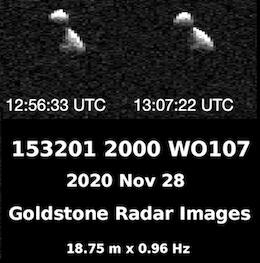
1566 Icarus is a large near-Earth object of the Apollo group and the lowest numbered potentially hazardous asteroid. It has is an extremely eccentric orbit (0.83) and measures approximately 1.4 km (0.87 mi) in diameter. In 1968, it became the first asteroid ever observed by radar. Its orbit brings it closer to the Sun than Mercury and further out than the orbit of Mars, which also makes it a Mercury-, Venus-, and Mars-crossing asteroid. This stony asteroid and relatively fast rotator with a period of 2.27 hours was discovered on 27 June 1949, by German astronomer Walter Baade at the Palomar Observatory in California. It was named after the mythological Icarus.
4486 Mithra, is an eccentric asteroid and suspected contact-binary, classified as near-Earth object and potentially hazardous asteroid, approximately 2 kilometers in diameter. It belongs to the Apollo group of asteroids and is a relatively slow rotator.
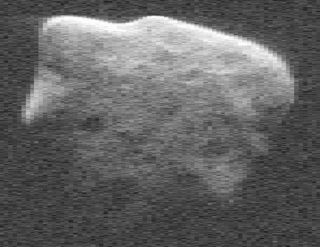
(53319) 1999 JM8 is an asteroid, slow rotator and tumbler, classified as a near-Earth object and potentially hazardous asteroid (PHA) of the Apollo group, approximately 7 kilometers (4 miles) in diameter, making it the largest PHA known to exist. It was discovered on 13 May 1999, by astronomers of the Lincoln Near-Earth Asteroid Research at the Lincoln Laboratory's Experimental Test Site near Socorro, New Mexico.
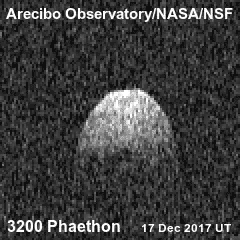
3200 Phaethon, provisionally designated 1983 TB, is an active Apollo asteroid with an orbit that brings it closer to the Sun than any other named asteroid. For this reason, it was named after the Greek myth of Phaëthon, son of the sun god Helios. It is 5.8 km (3.6 mi) in diameter and is the parent body of the Geminids meteor shower of mid-December. With an observation arc of 35+ years, it has a very well determined orbit. The 2017 Earth approach distance of about 10 million km was known with an accuracy of ±700 m.

1981 Midas, provisional designation 1973 EA, is a vestoid asteroid, classified as a near-Earth object and potentially hazardous asteroid, approximately 2 kilometers in diameter.
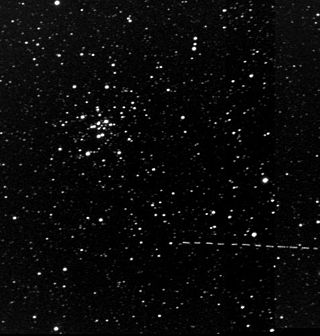
(33342) 1998 WT24 is a bright, sub-kilometer asteroid, classified as near-Earth object and potentially hazardous asteroid (PHA) of the Aten group, located in Venus's zone of influence that has frequent close encounters with Mercury, Venus, and Earth. It made a close approach to Earth on 11 December 2015, passing at a distance of about 4.2 million kilometers (2.6 million miles, 11 lunar distances) and reaching about apparent magnitude 11.

(524522) 2002 VE68, provisional designation 2002 VE68, is a sub-kilometer sized asteroid and temporary quasi-satellite of Venus. It was the first such object to be discovered around a major planet in the Solar System. In a frame of reference rotating with Venus, it appears to travel around it during one Venerean year but it actually orbits the Sun, not Venus.

3752 Camillo is an inclined contact-binary asteroid, classified as near-Earth object of the Apollo group, approximately 2.3 kilometers in diameter. It was discovered on 15 August 1985, by astronomers Eleanor Helin and Maria Barucci using a 0.9-metre (35 in) telescope at the CERGA Observatory in Caussols, France. Lightcurve studies by Petr Pravec in 1998 suggest that the assumed S-type asteroid has an elongated shape and a longer-than average rotation period of 38 hours.

3122 Florence is a stony trinary asteroid of the Amor group. It is classified as a near-Earth object and potentially hazardous asteroid. It measures approximately 5 kilometers in diameter. It orbits the Sun at a distance of 1.0–2.5 AU once every 2 years and 4 months ; the orbit has an eccentricity of 0.42 and an inclination of 22° with respect to the ecliptic. Florence has two moons.

(276033) 2002 AJ129, provisional designation 2002 AJ129, is a Mercury-crossing asteroid. It has the ninth-smallest perihelion of all numbered asteroids, after asteroids such as 2000 BD19, 2004 UL, and 2008 XM. It makes close approaches to all of the inner planets and asteroid 4 Vesta. The asteroid is estimated to be between 0.5–1.2 kilometers (0.3–0.7 mi) across. In January 2018 there was much media hype about this asteroid being classified as a potentially hazardous asteroid, although there is no known threat of an impact for hundreds if not thousands of years. The media has compared the size of the asteroid to the Burj Khalifa in Dubai.

(308242) 2005 GO21 is a large Aten near-Earth asteroid and potentially hazardous object. It has a well determined orbit with an observation arc of 7 years and an uncertainty parameter of 0. It was discovered on 1 April 2005 by the Siding Spring Survey at an apparent magnitude of 18.1 using the 0.5-metre (20 in) Uppsala Southern Schmidt Telescope.
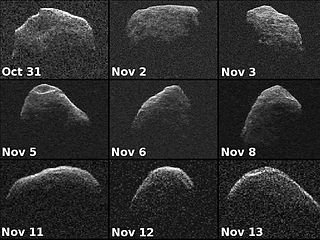
(214869) 2007 PA8 is an asteroid and slow rotator, classified as near-Earth object and potentially hazardous asteroid of the Apollo group, approximately 1.4 kilometers in diameter.
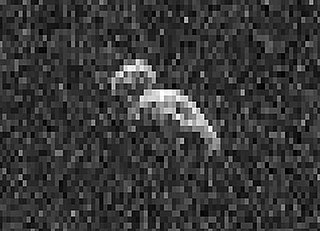
(388188) 2006 DP14, provisional designation 2006 DP14, is a sub-kilometer sized, peanut-shaped asteroid on a highly eccentric orbit, classified as near-Earth object and potentially hazardous asteroid of the Apollo group. This contact binary was discovered on 23 February 2006, by astronomers of the LINEAR program at the Lincoln Laboratory's Experimental Test Site near Socorro, New Mexico, in the United States. On 10 February 2014, it passed 6.25 lunar distances from Earth. The asteroid is approximately 400 meters in diameter and has a rotation period of 5.77 hours.

(52768) 1998 OR2 (provisional designation 1998 OR2) is an asteroid on an eccentric orbit, classified as a near-Earth object and potentially hazardous asteroid of the Amor group, with a diameter of 2 kilometers (1.2 mi). It was discovered on 24 July 1998, by astronomers of the Near-Earth Asteroid Tracking (NEAT) program at the Haleakala Observatory, Hawaii. It is one of the brightest and therefore largest potentially hazardous asteroids known to exist. With an observation arc of 35 years, the asteroid has a well-determined orbit, and its trajectory is well known through the year 2197. The asteroid's orbit is only potentially hazardous on a time scale of thousands of years.

(505657) 2014 SR339, provisional designation 2014 SR339, is a dark and elongated asteroid, classified as near-Earth object and potentially hazardous asteroid of the Apollo group, approximately 970 meters (3,200 feet) in diameter. It was discovered on 30 September 2014, by NASA's Wide-field Infrared Survey Explorer telescope (WISE) in Earth's orbit. Closely observed at Goldstone and Arecibo in February 2018, it has a rotation period of 8.7 hours.
(143651) 2003 QO104, provisional designation 2003 QO104, is a stony asteroid, slow rotator and suspected tumbler on a highly eccentric orbit, classified as near-Earth object and potentially hazardous asteroid of the Amor and Apollo group, respectively. It was discovered on 31 August 2003, by astronomers of the Near-Earth Asteroid Tracking program at the Haleakala Observatory in Hawaii, United States. The Q-type asteroid has a rotation period of 114.4 hours and possibly an elongated shape. It measures approximately 2.3 kilometers (1.4 miles) in diameter and belongs the largest potentially hazardous asteroids known to exist.
(163243) 2002 FB3, provisional designation 2002 FB3, is a stony asteroid on an eccentric orbit, classified as near-Earth object and potentially hazardous asteroid of the Athen group, approximately 1.6 kilometers (1 mile) in diameter. It was discovered on 18 March 2002, by astronomers with the Lincoln Near-Earth Asteroid Research at the Lincoln Laboratory's Experimental Test Site near Socorro, New Mexico, in the United States. The Q-type asteroid has a rotation period of 6.2 hours.

2017 YE5 is a binary pair of asteroids of approximately equal size and mass, each about 0.9 km (0.56 mi) in diameter. Classified as a near-Earth asteroid and potentially hazardous object of the Apollo group, 2017 YE5 was discovered by amateur astronomer Claudine Rinner at the Oukaïmeden Observatory on 21 December 2017. On 21 June 2018, the pair of asteroids passed within 15.5 lunar distances or approximately 6 million km (3.7 million mi) from Earth. During the close encounter, 2017 YE5 was resolved in high detail by concurrent radar observations by the Arecibo and Green Bank observatories, along with individual observations by the Goldstone Solar System Radar. 2017 YE5 is likely an extinct or dormant comet due to its distant elliptical orbit and dark red surface.

2020 BX12 is a sub-kilometer binary asteroid, classified as a near-Earth asteroid and potentially hazardous object of the Apollo group. It was discovered on 27 January 2020 by the Asteroid Terrestrial-impact Last Alert System survey at the Mauna Loa Observatory during its approach to Earth of 0.02915 AU (4.361 million km; 11.34 LD). Radar observations of the asteroid were carried out by the Arecibo Observatory on 4 February 2020, revealing a natural satellite orbiting 360 m (1,180 ft) from the primary body.

(85990) 1999 JV6, provisional designation 1999 JV6, is a sub-kilometer near-Earth asteroid and a potentially hazardous object of the Apollo group. It was discovered by astronomers of the LINEAR program at the Lincoln Laboratory's Experimental Test Site near Socorro, New Mexico. 1999 JV6 is a contact binary object consisting of two distinct lobes, as seen in radar images from various observatories including Arecibo and Goldstone in January 2015.
